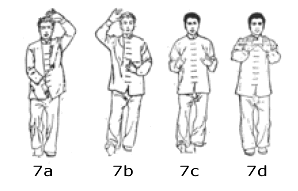San Ti Shi: "Three-Harmony" Standing ExerciseThe San Ti Shi is based on the stances used in the Xing Yi exercise which is said to have originated by General Yue Fei (1103-1142) of the Jin Dynasty or, according to authentic historical records, by Dai Longbang during the Qing Dynasty (1644-1911), who passed it on to Li Luoneng, a wushu master in Heibei Province. Using internal strength cultivated through this Xing Yi exercise, Li managed to conquer every single one of his adversaries in fighting contests and earned the nickname of Holy Fighter.
Li's style was later known as "neijia," or "internal school of boxing," which lays emphasis on developing internal strength through exercises. The most basic technique to be learned by a neijia practitioner is the standing exercise. As a saying among Li's descendants goes, "The standing exercise is to martial arts what a granary is to food grains."
The three-harmony standing exercise is explained in some of the writings by neijia masters, with the main points as follows:
1) Stand upright and turn the body 45 degrees to the right, using both heels as pivots. Bend both legs slightly so that the knees are directly above the toes. Meanwhile, clench both hands into fists and place them on the hips with palm side down.
2) As you inhale deeply, bring the right fist up to nose level with the arm held close to the body and turned externally so that the knuckles of the fist face forward, while the left fist remains on the hip with the knuckles turned downward.
3) As you exhale, lower the right fist to chest level and, with the left arm drawn close to the body, bring up the left fist to nose level, unclenching it when it passes over the right hand.
4) Then move the left foot about two foot lengths to the front and strike out with the left hand at nose level while unclenching the right fist into a palm and pressing it down to the right "riyue" point as if to protect the rib cage.
5) As the foot and hand movements are completed at the end of exhalation, both legs are slightly bent and the bulk of the body weight is on the rear leg, with the left arm bent at an angle of 135 degrees and the palm facing obliquely downward like a tiger's claw, that is, with thumb and index finger forming a semi-circle and the other fingers naturally extended.
6) Keep standing in this position for as long as you don't feel tired. Traditionally, one would stand for at least three minutes on each foot.
By "three harmonies" we mean, externally, 1) proper alignment between hands and feet (with fingers above toes); 2) proper alignment between shoulders and hips (also with the two on a vertical line); and 3) proper alignment between shoulders and hips (also with the two on a vertical line).
Furthermore, internally the term refers to 1) harmony between mind and will, which means that only with concentration of mind can you attain a state of tranquility and use the power of the will; 2) harmony between will and "chi", which means that only by the power of the will can chi be conducted up and down the body without interruption; and 3) harmony between chi and force, which means that the internal organs will relax when chi descends and contract when chi ascends, thus creating a force which, as vividly described in The Yellow Emperor's Canon of Internal Medicine, "lies hidden as if in a drawn crossbow and which is capable of displaying the power of a released arrow," a force that is often effectively used by wushu masters for knocking down their adversaries and by qigong masters for treating their patients.
In doing this exercise, you are required to keep your head and neck erect as though something were pulling you up by the hair or a heavy object were resting on the top of your head. At the same time, you must keep your belly and hips tucked in, so that the lower dantian will be filled with chi, which, by means of regulated respiration, will flow up into the upper dantian and down to yongquan points through the Eight Extra Channels in "large circles" and through the Ren and Du Channels in "small circles." Regular practice will produce curative effects on such chronic ailments as hypertension, arteriosclerosis and tachycardia.
http://www.suntaichi.com/santishi.html


















 Where's your imagination?
Where's your imagination? 





Where's your imagination?



